漲知識!用邏輯規則進行機器學習
Skope-rules使用樹模型生成規則候選項。首先建立一些決策樹,并將從根節點到內部節點或葉子節點的路徑視為規則候選項。然后通過一些預定義的標準(如精確度和召回率)對這些候選規則進行過濾。只有那些精確度和召回率高于其閾值的才會被保留。最后,應用相似性過濾來選擇具有足夠多樣性的規則。一般情況下,應用Skope-rules來學習每個根本原因的潛在規則。
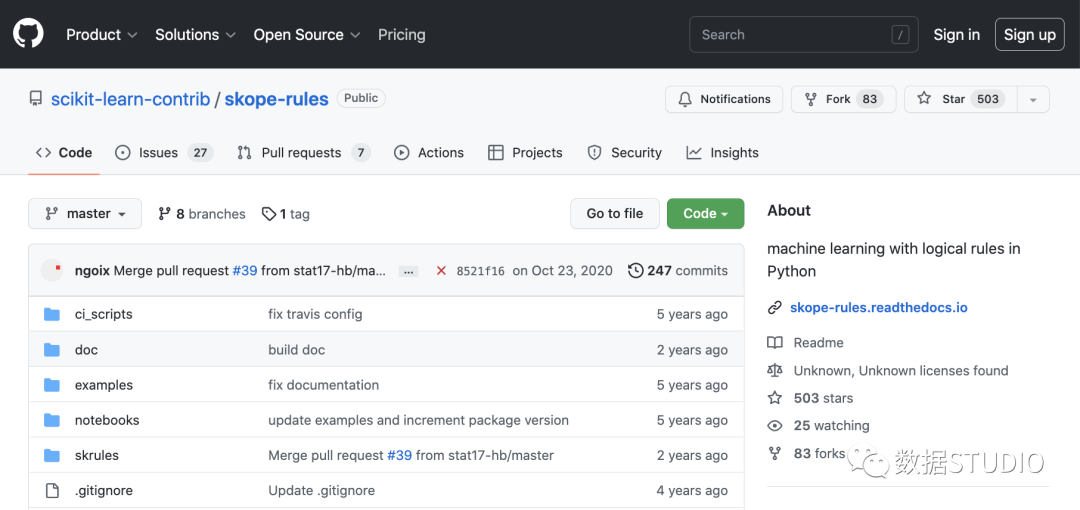
項目地址:https://github.com/scikit-learn-contrib/skope-rules
- Skope-rules是一個建立在scikit-learn之上的Python機器學習模塊,在3條款BSD許可下發布。
- Skope-rules旨在學習邏輯的、可解釋的規則,用于 "界定 "目標類別,即高精度地檢測該類別的實例。
- Skope-rules是決策樹的可解釋性和隨機森林的建模能力之間的一種權衡。
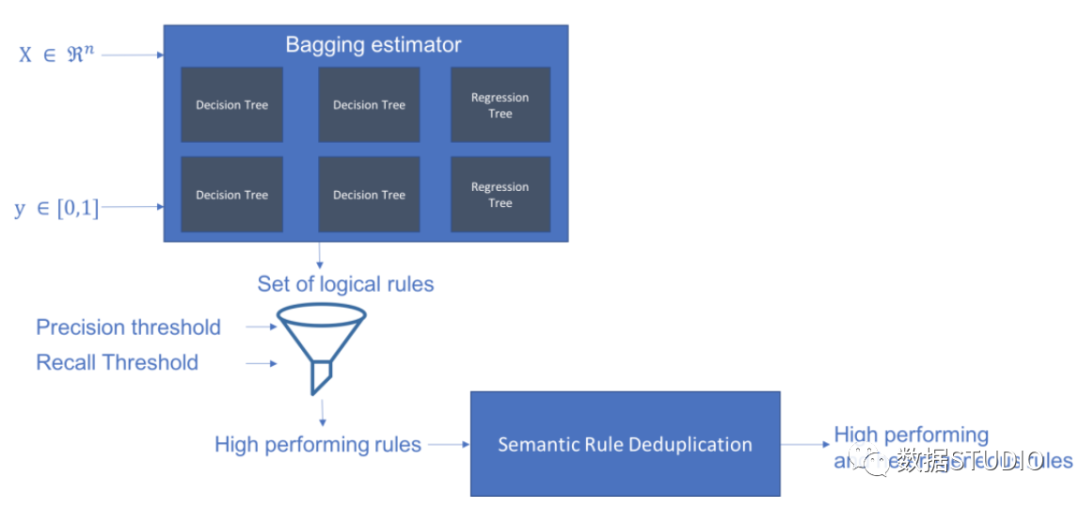
schema
安裝
可以使用 pip 獲取最新資源:
pip install skope-rules快速開始
SkopeRules 可用于描述具有邏輯規則的類:
from sklearn.datasets import load_iris
from skrules import SkopeRules
dataset = load_iris()
feature_names = ['sepal_length', 'sepal_width', 'petal_length', 'petal_width']
clf = SkopeRules(max_depth_duplicatinotallow=2,
n_estimators=30,
precision_min=0.3,
recall_min=0.1,
feature_names=feature_names)
for idx, species in enumerate(dataset.target_names):
X, y = dataset.data, dataset.target
clf.fit(X, y == idx)
rules = clf.rules_[0:3]
print("Rules for iris", species)
for rule in rules:
print(rule)
print()
print(20*'=')
print()
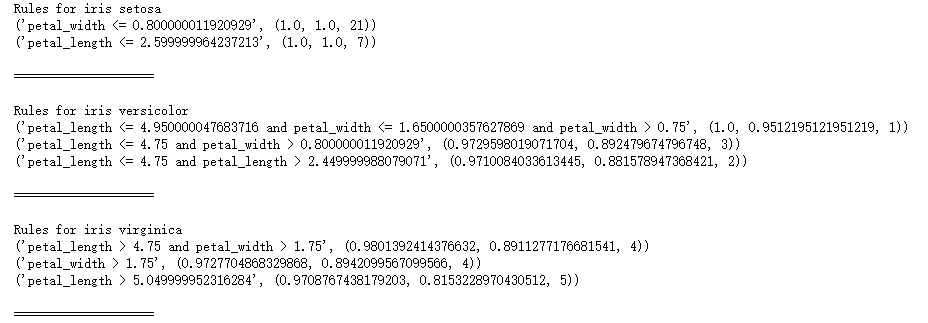
注意:
如果出現如下錯誤:
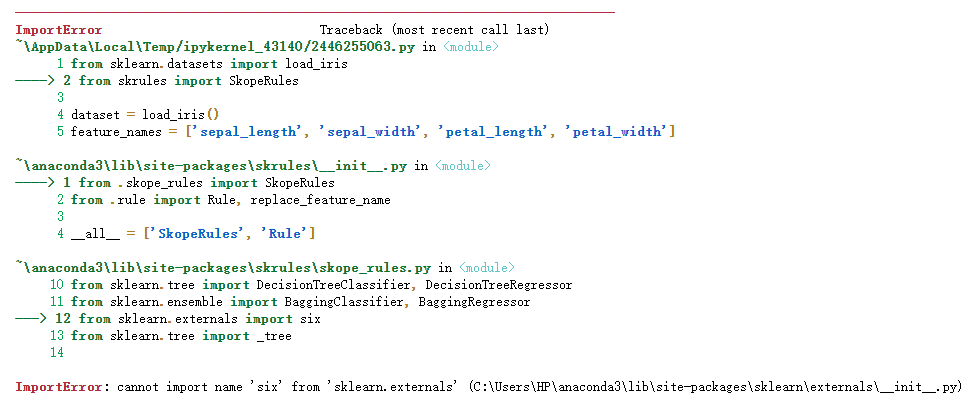
解決方案:
關于 Python 導入錯誤 : cannot import name 'six' from 'sklearn.externals' ,云朵君在Stack Overflow上找到一個類似的問題:https://stackoverflow.com/questions/61867945/
解決方案如下
import six
import sys
sys.modules['sklearn.externals.six'] = six
import mlrose
親測有效!
如果使用“score_top_rules”方法,SkopeRules 也可以用作預測器:
from sklearn.datasets import load_boston
from sklearn.metrics import precision_recall_curve
from matplotlib import pyplot as plt
from skrules import SkopeRules
dataset = load_boston()
clf = SkopeRules(max_depth_duplicatinotallow=None,
n_estimators=30,
precision_min=0.2,
recall_min=0.01,
feature_names=dataset.feature_names)
X, y = dataset.data, dataset.target > 25
X_train, y_train = X[:len(y)//2], y[:len(y)//2]
X_test, y_test = X[len(y)//2:], y[len(y)//2:]
clf.fit(X_train, y_train)
y_score = clf.score_top_rules(X_test) # Get a risk score for each test example
precision, recall, _ = precision_recall_curve(y_test, y_score)
plt.plot(recall, precision)
plt.xlabel('Recall')
plt.ylabel('Precision')
plt.title('Precision Recall curve')
plt.show()
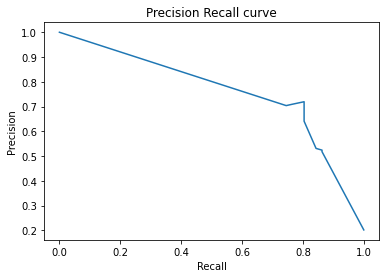
實戰案例
本案例展示了在著名的泰坦尼克號數據集上使用skope-rules。
skope-rules適用情況:
- 解決二分類問題
- 提取可解釋的決策規則
本案例分為5個部分
- 導入相關庫
- 數據準備
- 模型訓練(使用ScopeRules().score_top_rules()方法)
- 解釋 "生存規則"(使用SkopeRules().rules_屬性)。
- 性能分析(使用SkopeRules.predict_top_rules()方法)。
導入相關庫
# Import skope-rules
from skrules import SkopeRules
# Import librairies
import pandas as pd
from sklearn.ensemble import GradientBoostingClassifier, RandomForestClassifier
from sklearn.model_selection import train_test_split
from sklearn.tree import DecisionTreeClassifier
import matplotlib.pyplot as plt
from sklearn.metrics import roc_curve, precision_recall_curve
from matplotlib import cm
import numpy as np
from sklearn.metrics import confusion_matrix
from IPython.display import display
# Import Titanic data
data = pd.read_csv('../data/titanic-train.csv')
數據準備
# 刪除年齡缺失的行
data = data.query('Age == Age')
# 為變量Sex創建編碼值
data['isFemale'] = (data['Sex'] == 'female') * 1
# 未變量Embarked創建編碼值
data = pd.concat(
[data,
pd.get_dummies(data.loc[:,'Embarked'],
dummy_na=False,
prefix='Embarked',
prefix_sep='_')],
axis=1
)
# 刪除沒有使用的變量
data = data.drop(['Name', 'Ticket', 'Cabin',
'PassengerId', 'Sex', 'Embarked'],
axis = 1)
# 創建訓練及測試集
X_train, X_test, y_train, y_test = train_test_split(
data.drop(['Survived'], axis=1),
data['Survived'],
test_size=0.25, random_state=42)
feature_names = X_train.columns
print('Column names are: ' + ' '.join(feature_names.tolist())+'.')
print('Shape of training set is: ' + str(X_train.shape) + '.')
Column names are: Pclass Age SibSp Parch Fare
isFemale Embarked_C Embarked_Q Embarked_S.
Shape of training set is: (535, 9).
模型訓練
# 訓練一個梯度提升分類器,用于基準測試
gradient_boost_clf = GradientBoostingClassifier(random_state=42, n_estimators=30, max_depth = 5)
gradient_boost_clf.fit(X_train, y_train)
# 訓練一個隨機森林分類器,用于基準測試
random_forest_clf = RandomForestClassifier(random_state=42, n_estimators=30, max_depth = 5)
random_forest_clf.fit(X_train, y_train)
# 訓練一個決策樹分類器,用于基準測試
decision_tree_clf = DecisionTreeClassifier(random_state=42, max_depth = 5)
decision_tree_clf.fit(X_train, y_train)
# 訓練一個 skope-rules-boosting 分類器
skope_rules_clf = SkopeRules(feature_names=feature_names, random_state=42, n_estimators=30,
recall_min=0.05, precision_min=0.9,
max_samples=0.7,
max_depth_duplicatinotallow= 4, max_depth = 5)
skope_rules_clf.fit(X_train, y_train)
# 計算預測分數
gradient_boost_scoring = gradient_boost_clf.predict_proba(X_test)[:, 1]
random_forest_scoring = random_forest_clf.predict_proba(X_test)[:, 1]
decision_tree_scoring = decision_tree_clf.predict_proba(X_test)[:, 1]
skope_rules_scoring = skope_rules_clf.score_top_rules(X_test)
"生存規則" 的提取
# 獲得創建的生存規則的數量
print("用SkopeRules建立了" + str(len(skope_rules_clf.rules_)) + "條規則\n")
# 打印這些規則
rules_explanations = [
"3歲以下和37歲以下,在頭等艙或二等艙的女性。"
"3歲以上乘坐頭等艙或二等艙,支付超過26歐元的女性。"
"坐一等艙或二等艙,支付超過29歐元的女性。"
"年齡在39歲以上,在頭等艙或二等艙的女性。"
]
print('其中表現最好的4條 "泰坦尼克號生存規則" 如下所示:/n')
for i_rule, rule in enumerate(skope_rules_clf.rules_[:4])
print(rule[0])
print('->'+rules_explanations[i_rule]+ '\n')
用SkopeRules建立了9條規則。
其中表現最好的4條 "泰坦尼克號生存規則" 如下所示:
Age <= 37.0 and Age > 2.5
and Pclass <= 2.5 and isFemale > 0.5
-> 3歲以下和37歲以下,在頭等艙或二等艙的女性。
Age > 2.5 and Fare > 26.125
and Pclass <= 2.5 and isFemale > 0.5
-> 3歲以上乘坐頭等艙或二等艙,支付超過26歐元的女性。
Fare > 29.356250762939453
and Pclass <= 2.5 and isFemale > 0.5
-> 坐一等艙或二等艙,支付超過29歐元的女性。
Age > 38.5 and Pclass <= 2.5
and isFemale > 0.5
-> 年齡在39歲以上,在頭等艙或二等艙的女性。
def compute_y_pred_from_query(X, rule):
score = np.zeros(X.shape[0])
X = X.reset_index(drop=True)
score[list(X.query(rule).index)] = 1
return(score)
def compute_performances_from_y_pred(y_true, y_pred, index_name='default_index'):
df = pd.DataFrame(data=
{
'precision':[sum(y_true * y_pred)/sum(y_pred)],
'recall':[sum(y_true * y_pred)/sum(y_true)]
},
index=[index_name],
columns=['precision', 'recall']
)
return(df)
def compute_train_test_query_performances(X_train, y_train, X_test, y_test, rule):
y_train_pred = compute_y_pred_from_query(X_train, rule)
y_test_pred = compute_y_pred_from_query(X_test, rule)
performances = None
performances = pd.concat([
performances,
compute_performances_from_y_pred(y_train, y_train_pred, 'train_set')],
axis=0)
performances = pd.concat([
performances,
compute_performances_from_y_pred(y_test, y_test_pred, 'test_set')],
axis=0)
return(performances)
print('Precision = 0.96 表示規則確定的96%的人是幸存者。')
print('Recall = 0.12 表示規則識別的幸存者占幸存者總數的12%\n')
for i in range(4):
print('Rule '+str(i+1)+':')
display(compute_train_test_query_performances(X_train, y_train,
X_test, y_test,
skope_rules_clf.rules_[i][0])
)
Precision = 0.96 表示規則確定的96%的人是幸存者。
Recall = 0.12 表示規則識別的幸存者占幸存者總數的12%。
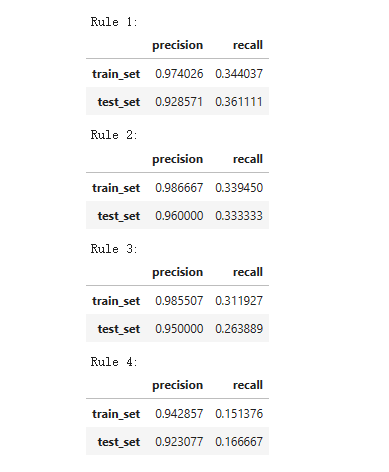
模型性能檢測
def plot_titanic_scores(y_true, scores_with_line=[], scores_with_points=[],
labels_with_line=['Gradient Boosting', 'Random Forest', 'Decision Tree'],
labels_with_points=['skope-rules']):
gradient = np.linspace(0, 1, 10)
color_list = [ cm.tab10(x) for x in gradient ]
fig, axes = plt.subplots(1, 2, figsize=(12, 5),
sharex=True, sharey=True)
ax = axes[0]
n_line = 0
for i_score, score in enumerate(scores_with_line):
n_line = n_line + 1
fpr, tpr, _ = roc_curve(y_true, score)
ax.plot(fpr, tpr, linestyle='-.', c=color_list[i_score], lw=1, label=labels_with_line[i_score])
for i_score, score in enumerate(scores_with_points):
fpr, tpr, _ = roc_curve(y_true, score)
ax.scatter(fpr[:-1], tpr[:-1], c=color_list[n_line + i_score], s=10, label=labels_with_points[i_score])
ax.set_title("ROC", fnotallow=20)
ax.set_xlabel('False Positive Rate', fnotallow=18)
ax.set_ylabel('True Positive Rate (Recall)', fnotallow=18)
ax.legend(loc='lower center', fnotallow=8)
ax = axes[1]
n_line = 0
for i_score, score in enumerate(scores_with_line):
n_line = n_line + 1
precision, recall, _ = precision_recall_curve(y_true, score)
ax.step(recall, precision, linestyle='-.', c=color_list[i_score], lw=1, where='post', label=labels_with_line[i_score])
for i_score, score in enumerate(scores_with_points):
precision, recall, _ = precision_recall_curve(y_true, score)
ax.scatter(recall, precision, c=color_list[n_line + i_score], s=10, label=labels_with_points[i_score])
ax.set_title("Precision-Recall", fnotallow=20)
ax.set_xlabel('Recall (True Positive Rate)', fnotallow=18)
ax.set_ylabel('Precision', fnotallow=18)
ax.legend(loc='lower center', fnotallow=8)
plt.show()
plot_titanic_scores(y_test,
scores_with_line=[gradient_boost_scoring, random_forest_scoring, decision_tree_scoring],
scores_with_points=[skope_rules_scoring]
)
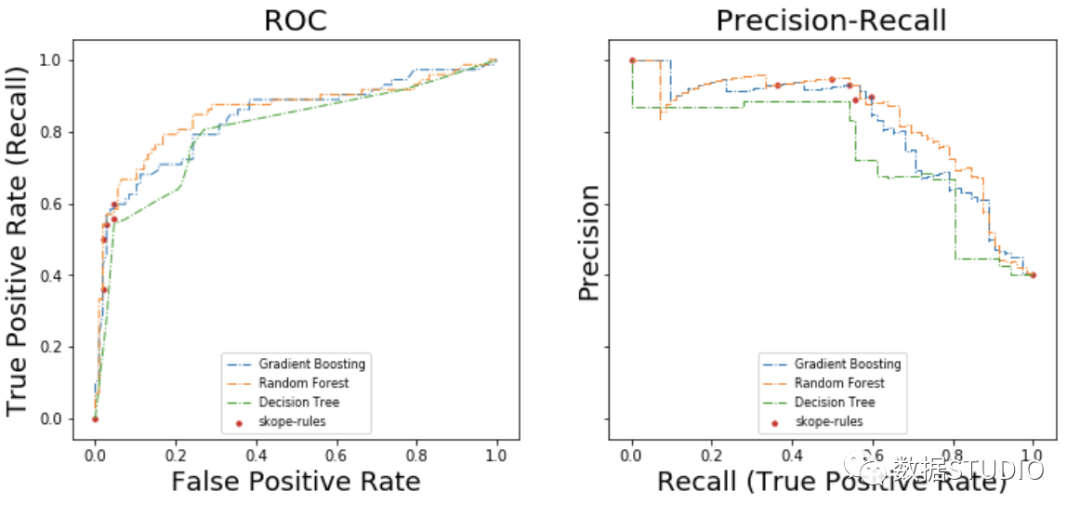
在ROC曲線上,每個紅點對應于激活的規則(來自skope-rules)的數量。例如,最低點是1個規則(最好的)的結果點。第二低點是2條規則結果點,等等。
在準確率-召回率曲線上,同樣的點是用不同的坐標軸繪制的。警告:左邊的第一個紅點(0%召回率,100%精度)對應于0條規則。左邊的第二個點是第一個規則,等等。
從這個例子可以得出一些結論。
- skope-rules的表現比決策樹好。
- skope-rules的性能與隨機森林/梯度提升相似(在這個例子中)。
- 使用4個規則可以獲得很好的性能(61%的召回率,94%的精確度)(在這個例子中)。
n_rule_chosen = 4
y_pred = skope_rules_clf.predict_top_rules(X_test, n_rule_chosen)
print('The performances reached with '+str(n_rule_chosen)+' discovered rules are the following:')
compute_performances_from_y_pred(y_test, y_pred, 'test_set')

predict_top_rules(new_data, n_r)方法用來計算對new_data的預測,其中有前n_r條skope-rules規則。



































